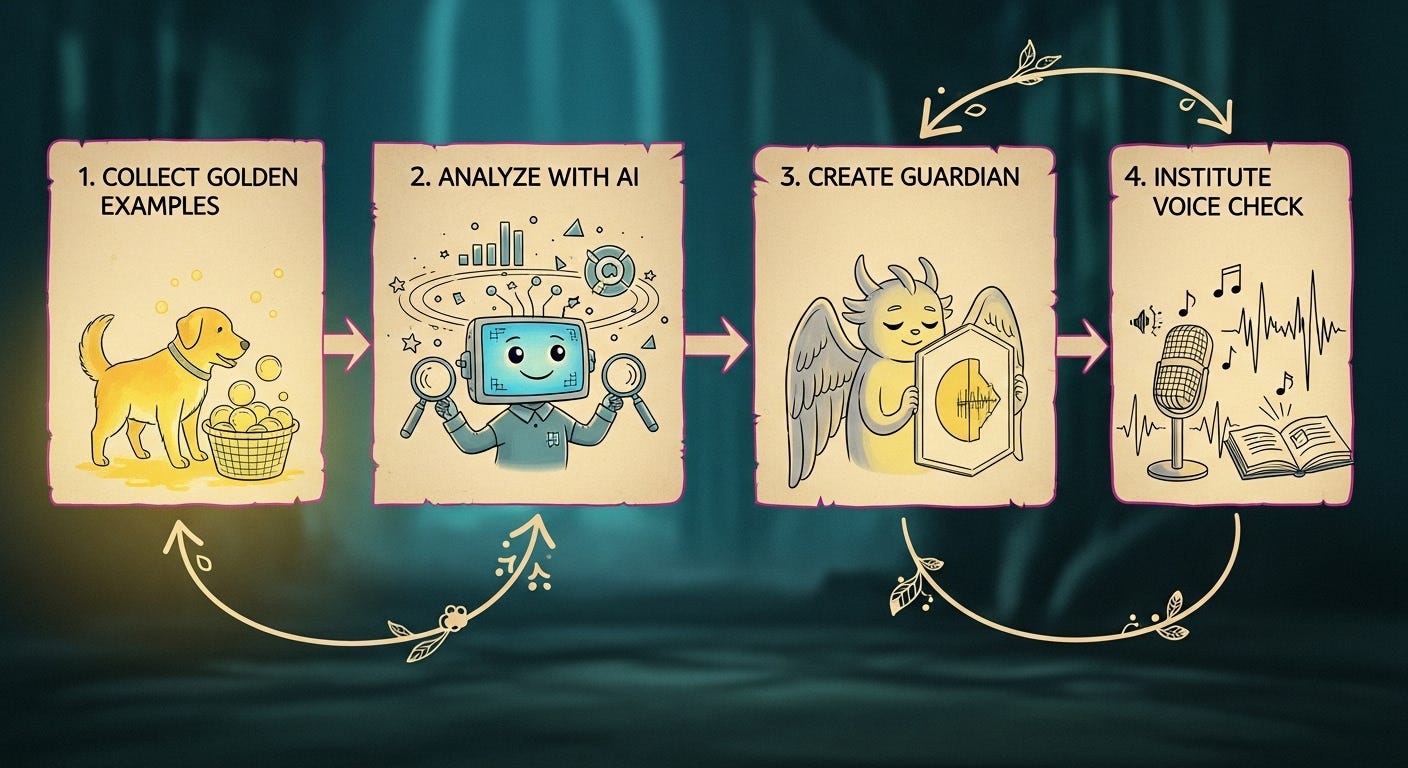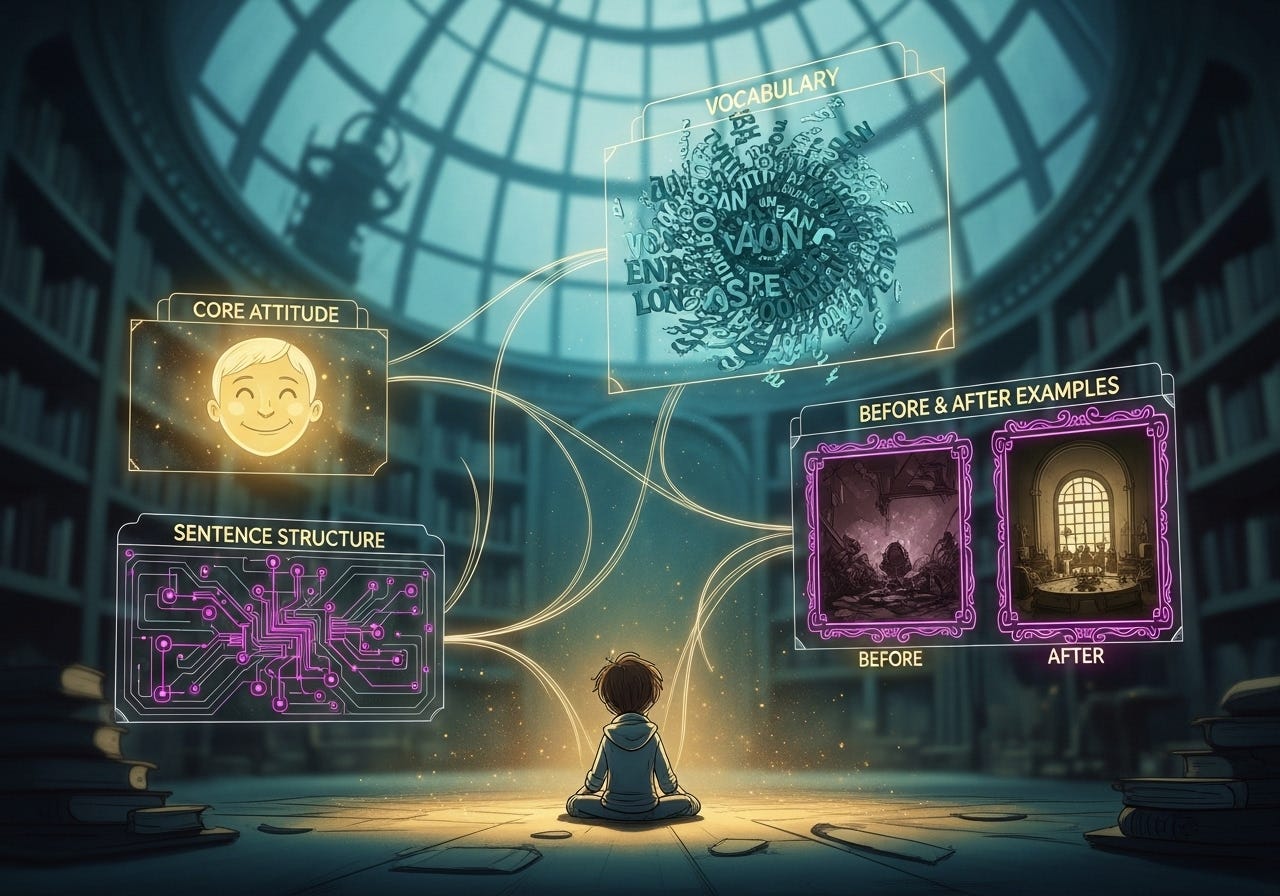There's a ghost in our machine and it sounds just like me
How to train an AI on your "golden" writing to solve marketing's most human problem.
Welcome to today’s edition of ROBOTS ATE MY HOMEWORK. Today we’re translating our gut feelings into a language a machine can understand.
For over a thousand years, Egyptian hieroglyphs were a beautiful, useless mystery. An entire culture's voice, carved in stone, was silent. Scholars could see the elegance, but they couldn't grasp the meaning.
The discovery of the Rosetta Stone changed everything.
Instead of a simple vocabulary list, it actually revealed the system by showing the same message in three different scripts. It was a decoder ring for a civilization.
Most founders have the same problem.
Their best, most persuasive writing feels like hieroglyphs. It's potent, it connects, but they can’t for the life of them explain why it works.
It’s a gut feeling, an instinct... and you can't scale instinct. You can't hand a gut feeling to a freelancer or a new marketing hire.
And so, the brand’s true voice remains trapped, a beautiful but silent script known only to one person.
Today, I’m giving you the Rosetta Stone for your brand. Here's what's inside:
The "Brand Voice Guardian" workflow for analyzing, codifying, and policing your brand voice.
The philosophy that will save your content from drowning in a sea of sameness.
A killer prompt for rewriting bad copy, plus a gold-standard example you can steal.
🤖 ROBOT REPORT CARD
It's one thing to talk about a "Rosetta Stone," but what does it actually look like to build one?
When we first started Yahini, our brand voice was a mess. Even at our previous content agency, it was a struggle.
One day, I'd write an email that sounded like me, and the next day our freelancer would publish a blog post that sounded like a LinkedIn automaton. It was driving me insane because it felt like our brand had no solid ground to stand on.
This workflow is the exact system I built to fix our own mess.
I call it the "Brand Voice Guardian" workflow.
It’s four steps. Don't skip any.
Step 1: First, find your 💫golden💫 examples
The goal is to find 3-5 pieces of writing that perfectly represent the voice you're aiming for. What you're looking for is writing that has a specific, tangible feeling. It has a point of view. It takes a stand.
I made the mistake initially of picking things I thought were “aspirational” - writing from huge brands that sounded authoritative. The AI gave me a voice guide that was cold, distant, and completely wrong for us.
So, for round two, we got specific.
Create a folder called “The Golden File.” For every piece of text you add, leave a comment explaining why it's in there. Be specific.
“The rhythm of these sentences feels urgent and confident.” Or, “This paragraph explains a complex idea without dumbing it down.”
Here’s where we found our real golden examples:
Unfiltered sent emails: I searched my “Sent” folder for emails to collaborators and early customers where I was trying to be exceptionally clear and persuasive. This is often where your most authentic voice lives, because you aren't “writing marketing copy,” you're just trying to communicate.
The “Flow State” blog post: I had one post from 2 years ago that I wrote in a single two-hour session. I didn't overthink it. Reading it back, it was direct, a little bit edgy, and built on a strong opinion.
A specific competitor's About page: We found an About page from a company in a totally different industry that was just brilliant. It was vulnerable, story-driven, and confident. We didn't want their words, but their stance.
What you do here is collect the evidence.
Step 2: Then, we created an AI brand strategist
Now you take your golden examples and feed them to the robots. But you can't be lazy about it. Your goal is to get the AI to act like a world-class literary analyst. It needs to decode the patterns you feel but can't articulate (which is the magic of it, really).
In our case, the AI's analysis pointed out something I had never consciously realized: our best writing was full of counterintuitive claims (“AI is a powerful intern, not a replacement”) and used specific, almost tactile words (grind, brittle, unflinching).
Here's the prompt we use. I'm going to break down why each section is critical:
You are a world-class brand strategist and linguist. I have provided you with several text samples that represent a brand voice I admire. Analyze this collection of texts as a whole and create a comprehensive 'Brand Voice & Tone Guide.' Your analysis must be deep and actionable.
Create the following sections:
1. Core Attitude: In 3-4 sentences, describe the core worldview or attitude of this voice. Is it optimistic but pragmatic? Authoritative but empathetic? Skeptical but helpful?
2. Vocabulary:
- Words to Use (The Lexicon): List 15-20 words and phrases that give this voice its distinct character.
- Words to Avoid: List 15-20 words and concepts that would feel out of place.
3. Sentence Structure & Pacing: Describe the rhythm of the writing. Does it use short, punchy sentences? Long, lyrical ones? A mix? How does it use paragraph breaks to create a specific reading experience?
4. Three "Before & After" Examples: Create three examples of a generic sentence and then rewrite it to fit this specific brand voice, explaining the logic behind each change.
Here are the text samples: [Paste your 3-5 "golden" examples here]Why the “Core Attitude” section matters:
This is the strategy. Is your brand a skeptical professor, an enthusiastic coach, or a pragmatic engineer? This defines the why behind your word choices.
Why the “Vocabulary” section matters:
This is about building a custom dictionary. For us, the AI identified that we use words like potent, workflow, and playbook and avoid corporate fluff like leverage, synergize, and unlock. This section creates a practical, copy-and-paste list for any writer.
Why the “Sentence Structure” section matters:
This controls the feeling. Short, punchy sentences create urgency. Longer, more complex ones feel thoughtful and deliberate. The AI noticed we often follow two short sentences with a longer one to make a key point.
Why the “Before & After” section matters:
This is where you're forcing the AI to demonstrate its understanding. It's the difference between telling someone the rules of chess and making them play a game.
Don't accept the first output as gospel. Argue with the AI. If its analysis feels a bit off, push back.
Say:
“That's a good start, but you missed the subtle humor in example three. Re-analyze and create a new section called 'Use of Wit' that defines how the voice uses humor to build rapport.”
The first output is a draft, not a final verdict.
Step 3: Create your “Guardian”
A brilliant voice guide buried in Google Drive is worthless. I've created so many documents that died a lonely death.
You have to integrate it into your team's daily workflow.
The simple route (low friction): Create a one-page summary. Make it a visual, like a poster. Pin that summary in your marketing Slack channel. It sounds cheesy, but it keeps the principles top-of-mind.
The better route (high impact): We saved the big voice guide the AI generated as a
.txtfile. We trained a new LLM, uploaded that file as the “Knowledge” section, and gave it a simple prime directive in the “Instructions” field: “Your primary role is to act as our Brand Voice Guardian. You must analyze and rewrite text to strictly adhere to the principles in the uploaded guide. You are helpful, direct, and an expert on our voice.” We named it “The Mia-Bot” (it would be flattering if you’d do the same 😂)
Step 4: Institute the voice check
This is the final, non-negotiable gate, the quality control step that makes the whole system work.
It might feel like a drag at first, but this discipline is what separates a brand with a real voice from one that's just making it up as they go.
Don't just use it on final drafts. That's a rookie mistake. Use it as a sparring partner.
Stuck on an intro paragraph? Write a terrible version and ask the Guardian to fix it.
Have a list of 10 headline ideas? Drop them in and ask, “Which of these best fits our voice and why?”
Need to write a difficult email to a customer? Draft it and ask the Guardian to “make this more empathetic without being apologetic, according to our voice guide.”
Here's a real-world example. A first draft of a sentence for our website might read:
“Yahini is a powerful software solution that helps marketers leverage AI to create better content briefs and optimize their workflow.”
We'd run that through the Guardian, and it would come back with something like:
Rejected. Too passive and full of jargon. 'Leverage,' 'solution,' and 'optimize' are on our 'Words to Avoid' list. The tone is generic.
Suggestion: 'Yahini thinks like a content strategist, not a writer. It handles the grueling research so you can build expert-level content briefs that actually work.'
This workflow removes the guesswork and subjectivity from editing. It allows you to scale your content creation with freelancers, new team members, or even AI writers, without diluting the one thing that makes you, you.
💡 A NEW CONCEPT FOR YOU
I know what you’re thinking. A voice guide feels like marketing homework. But I need you to understand…
Why does this matter so much right now?
Because while you're working to build something with a soul, the rest of the world is building a machine designed to destroy it. To understand the war your brand is fighting, you need to know the name of your real enemy.
It's a concept called Dopamine Culture.
Ted Gioia coined the term in his phenomenal essay, "The State of the Culture, 2024." His argument is simple: the dominant force in our society is no longer art or even entertainment. It's distraction.
As Gioia puts it:
The fastest growing sector of the culture economy is distraction. Or call it scrolling or swiping or wasting time or whatever you want. But it’s not art or entertainment, just ceaseless activity. The key is that each stimulus only lasts a few seconds, and must be repeated.
This is a business model built on our brain chemistry.
Every short video, every endless scroll, every notification is engineered to deliver a tiny hit of dopamine. It creates an addictive loop that keeps us scrolling, swiping, and clicking. Addiction is the goal.
So what does this have to do with our convo today?
Generic AI content is the perfect fuel for the Dopamine Culture fire.
You can use AI to join the "dopamine cartel." You can churn out endless, low-value, generic content that pollutes the internet and hopes to catch a few seconds of compulsive attention.
Or, you can do the opposite.
The workflow we just designed is the cure to dopamine culture. It's a system for using AI to create a voice with so much personality, depth, and humanity that it breaks the scroll.
That is the only long-term way to win.
✨ ONE MORE THING...
Here are two things you can use this afternoon.
First, a brutally effective prompt for rewriting copy on the fly. This is perfect for when you've written something that just doesn't feel right yet.
My go-to prompt for this:
Here are two pieces of writing.
The first is an example of our desired brand voice: [paste your 'golden' text 1].
The second is a draft I wrote: [paste your draft text 2].
Rewrite the second text so that it perfectly matches the voice, tone, rhythm, and vocabulary of the first one.Second, go look at a gold-standard example of this done in public. Mailchimp's Content Style Guide has been the benchmark for years. It's a masterclass in documenting a brand voice with clarity and personality. Study it. Steal the structure.
So, after all that, I have a question for you:
If your brand were a character in a movie or TV show, who would it be?
Let’s be super creative with this :)
To making them listen,
Chief 🤖 at ROBOTS ATE MY HOMEWORK









